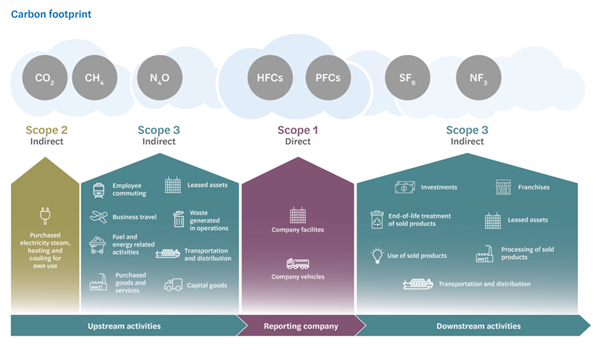Carbon Footprinting
As a fundamental first step in implementing an emissions reduction plan, working out your carbon footprint also helps you gain a competitive advantage in a rapidly evolving marketplace.
How we can help
Our market-leading carbon footprinting tool provides a georeferenced solution across all emissions scopes. This allows for detailed customisation based on each organisation's specific activities, supply chains, and site locations, based on:
- 180,000+ continually updated emissions factors and assumptions
- 411 institutions and sources
- 1,000,000+ tracked areas of interest
Our platform generates detailed reports compliant with the ever-growing number of disclosure schemes, including the CDP, ISO14064-1 and the WBCSD/WRI’s GHG Protocol. Over time, subsequent assessments can be added, allowing you to track improvement and KPI evolution.
Net Zero
Embarking on a net zero trajectory demonstrates a commitment to being a responsible organisation as well as contributing to the UK's 2050 net zero ambitions.
Our net zero consulting approach follows the methodology of the Task Force on Climate-related Financial Disclosures (TCFD), which is a framework consisting of 11 recommended disclosures for consistent reporting on climate-related risk.
How we can help
We will support you in understanding the complexities in the details of the commitment to net zero and ensure that a cohesive emissions reduction strategy is tailored around your business activities and operations. The emissions reduction strategy will focus on the four pillars of the TCFD, as well as emissions measurement and reporting. The four pillars of the TCFD are:
- Governance – the organisation's governance around climate-related risks and opportunities
- Strategy – the actual and potential impacts of climate-related risks and opportunities on the organisation's business, strategy, and financial planning
- Risk management – the processes used by the organisation to identify, assess, and manage climate-related risks
- Metrics and targets – the metrics and targets used to assess and manage relevant climate-related risks and opportunities, including your net zero target
We assist in setting and registering a Science Based Target to ensure that your net zero journey is informed by the latest climate science. We also provide support for preparing your Climate Disclosure Project (CDP) submission, ensuring that you have all the information required to achieve a score that is a true reflection of your organisation's decarbonisation efforts.
Streamlined Energy and Carbon Reporting (SECR)
This reporting policy was introduced by the UK Government in 2019. Under SECR legislation, certain organisations must report on their energy use and carbon emissions within their annual reports.
The legislation affects:
- quoted companies;
- large unquoted companies; and
- large limited liability partnerships (LLPs).
A company is considered 'large' if it meets two of the following three criteria:
How we can help
Mazars can support you with your Streamlined Energy and Carbon Reporting. We understand the complexities of the requirements and will consider your wider business functions when preparing the report. Mazars' SECR methodology accounts for stakeholder interest, legal requirements, and where SECR can add value to our clients.
During an SECR engagement, we will help with:
- Scoping – Understanding which entities and parts of your business fall within the requirements, including whether any exemptions are able to be applied.
- Collection and measuring data – Establishing the appropriate systems to collect and measure data, ranging from simplified approaches to building and developing management information systems linked to reporting systems.
- Calculation of carbon emissions – In accordance with the Greenhouse Gas Reporting Protocol – Corporate Standard and HM Government emission factors for greenhouse gas company reporting.
- Reporting – Drafting the energy use and emissions information for disclosure within your annual report.
- Benchmarking – Provide you with assurance that your energy use and emission information is appropriate for your business, comparing your information to benchmarked companies and best practices
Get in touch
If you would like to discuss how the sustainability services team can help with decarbonisation at your organisation, please do not hesitate to contact us.
FAQs
What is a carbon footprint?
A carbon footprint is the quantification of the total greenhouse gases (GHG) produced directly and indirectly from a business or organisation's activities.
Under the WBCSD/WRI’s Greenhouse Gas Protocol, which provides the global standardised framework to measure and manage GHG emissions, carbon footprints are made up of emissions from three distinct scopes:
- Scope 1 includes direct GHG emissions from sources that are owned or controlled by the organisation. E.g. (emissions associated with): natural gas combustion from boiler usage, fuel burned by an organisation’s vehicles
- Scope 2 accounts for indirect GHG emissions that a company creates indirectly when the energy it purchases, and uses, is produced. E.g. (emissions associated with): electricity used to power an organisation’s sites
- Scope 3 includes all emissions that an organisation is indirectly accountable for, up and down its value chain. E.g. (emissions associated with): business travel, waste treatment, purchased goods, etc.
Why measure your carbon footprint?
As well as a complete understanding of your organisation’s environmental impact, there are a number of value-adding benefits to measuring and reporting your carbon footprint:
Measuring your organisation’s carbon footprint is a fundamental first step in implementing an emissions reduction plan. Understanding current emissions provides a baseline from which to work towards Net Zero emissions by 2050, or earlier.
As the economy transitions towards Net Zero, upstream and downstream stakeholders are already requesting carbon footprint data from the organisations that they work with. Knowing your own carbon footprint will make you a more attractive organisation to work with, as your data will assist stakeholders in the measurement of their own Scope 3 emissions more accurately.
Carbon footprinting can identify areas of inefficiency within your organisation. When breaking down your emissions by different sites or units, you may encounter ‘hotspots’ where emissions spike. These can be quickly addressed, reducing operational costs and reducing environmental impact.
Understanding your carbon footprint helps you to quantify your sustainability reporting. This will make reporting processes more robust, meaning external assurance can be provided on your sustainability reports.
What does net zero mean?
According to the Science Based Targets Initiative (SBTi), achieving net zero means reducing Scope 1, 2, and 3 emissions to zero, or a residual level consistent with achieving 1.5ºC of global warming, and neutralising any residual emissions. Under the SBTi framework, most sectors are required to realise a 90% absolute reduction in emissions before residual emissions can be neutralised.
What does net zero mean for businesses?
Net zero is about future-proofing your business and meeting the needs of your stakeholders by setting targets which align with the legally binding commitments made under the Paris Agreement. However, it is not enough to set targets alone – these must be grounded in an achievable decarbonisation roadmap which is woven into your business strategy and financial planning, so that their attainment is realistic at an operational level. A net zero roadmap should be ambitious, but also meaningful in the context of your business strategy, drawing on tangible decarbonisation levers to reach your commitments.
What if I have not collected data for the measurement of my carbon footprint?
The majority of organisations that approach us are at the very beginning of their net zero journeys and have not yet begun to collect detailed emissions-related data. Our sophisticated carbon footprinting tool has the ability to use proxies and spend-based data to calculate your baseline carbon footprint, and as part of our engagement, we will help you to identify data that you should be collecting going forward to improve the accuracy and granularity of your footprint in future years.
We can also work with you to develop a programme for engagement with your suppliers since we have found in practice that Scope 3 Category 1 ‘Purchased goods and services’ very often represents the most material category of emissions for our clients. This will improve both the accuracy of your data and the buy-in to your net zero roadmap.
How will a net zero roadmap meet the needs of different stakeholders?
The UK government has made a legally binding commitment to reach net zero emissions by 2050 and organisations across the private and public sector have a pivotal role to play in this. Customers, employees and providers of finance are increasingly expecting organisations to demonstrate coherence between their internal targets and the UK’s commitment, so having a clear strategy in place for decarbonisation is critical to the future viability of your organisation.
Our net zero roadmaps are fully aligned with the requirements of the Science Based Targets Initiative (SBTi). They are based on a robust internal logic which will comply with the expectations of a wide variety of stakeholders. Moreover, by engaging extensively with internal management and strategic decision-makers, we ensure that the decarbonisation levers we use are tailored and achievable in the context of your organisation.
This website uses cookies.
Some of these cookies are necessary, while others help us analyse our traffic, serve advertising and deliver customised experiences for you.
For more information on the cookies we use, please refer to our Privacy Policy.
-
This website cannot function properly without these cookies.
-
Analytical cookies help us enhance our website by collecting information on its usage.
-
We use marketing cookies to increase the relevancy of our advertising campaigns.







